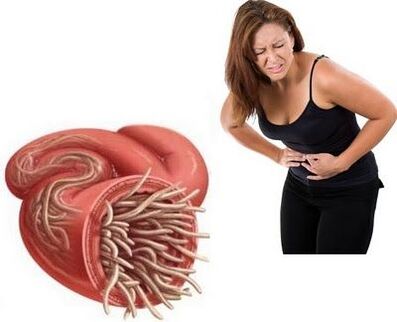Parasites - this is the name of one of the most common groups of infectious diseases.Today, about 300 parasites are known, which pose a danger to people, including fatal.On the territory of the European continent, these are only a few dozen parasites (medical name - helminth, helminth invasion).
The largest part of human-related parasites is common in countries with tropical and subtropical climate, as well as a low level of socio-economic development and sanitary culture.
What are the dangerous parasites

Parasites in the human body can affect almost any organ system.The degree of damage depends on the type of helminth, the duration of the disease, the initial state of health.The earlier the diagnosis of a specific helminth invasion, the more chance of getting rid of the parasite quickly.Therefore, it is important to diagnose the condition of parasites in time and to perform all stages of treatment.
Almost every variant of helminthiasis, especially for a long time, causes significant harm to the human body.Hlibonian invasion is the reason for the delay in psychomotor development in children of any age, significantly reducing the results and stocks of life in adults.
Regardless of the age of a person, the helminth invasion contributes to allergies, reduces the ability of the immune system to oppose infectious and other diseases, in addition, the effectiveness of the continuing vaccine is significantly reduced.
Cleansing the body of parasites in rare cases becomes spontaneous, in most cases specific treatment is required according to a particular regimen.
What are the parasites

Parasites (they are also worms or worms) are an extensive group of multicellular complex organisms that can exist for a long time in active condition in different conditions.An important characteristic is the ability to exist within another living organism (human or animal), which is called an "invasion."
Different types of parasites are currently known in the human body.The most common classification of parasites depending on their external structure and the characteristics of the life cycle.
Given the biological characteristics, all parasites are divided into 3 large classes:
- Roundworms (they are also nematodes), for example, trichinella, ankylostoma, pin, ascaris;
- Ground worms (they are also cestodes), for example, Alveococcus, Echinococcus, wide tape, bull -clinical tapeen, pork and dwarf;
- Superi (they are also tremony), for example, Opistorch, Fasciol, Clonorch.
In addition, like many other diseases, parasitic diseases differ:
- in weight;
- through the leading syndrome, that is, which system of organs is damaged to a greater extent;
- from the presence and nature of complications;
- By the possible result of the disease.
Characteristics of parasites
Development
Parasitic diseases are characterized by a number of differences related to the characteristics of parasites and their life cycle.
The number of adults from parasites in the human body does not increase, provided there is no new infection.For the application of the life cycle, most parasites require a change in habitat (animal body, soil, etc.).
For each parasite, the stages of development are typical.Throughout the life cycle, Helmint transmits a number of ever -changing stages of development.As a rule, the egg of the parasites is transformed into a larva and further into an adult individual.The reverse development does not happen, the egg cannot immediately go to the stage of an adult.
The parasite penetrates into the human body at one stage of its life cycle and goes out into another.It is at this point that the non -separation of the practical faces of human parasitic diseases is related.That is, it is impossible to become infected with the greater part of parasitic diseases in direct contact with an infected person.
Possible paths of penetration into the human body
With many types of parasites, one can meet anywhere - he is not visible in the naked eye.The following options are most likely:
- The oral path, that is, with a discrepancy with personal hygiene, the use of dirty or thermally unprocessed products;
- The percutaneous path, that is, larvae or adults from parasites penetrate the human body through damage to the skin when contacting water or soil, with the participation of blood, the remaining insects.
Most of the parasites that affect the human body live in it only in the stage of adults, mainly in the digestive tract.These are the so -called intestinal parasites (Helminths).They, in turn, are divided into 2 groups in accordance with some characteristics.
The intestinal parasites of the first group enter the human body in the form of an egg.In the digestive tract, they are transformed into an adult individual.The movements of such parasites (Pinworms, a wide ribbon, pork and bull tapeworm) are limited only by different departments of the digestive tract.
Representatives of the second group (their larvae or eggs) perform a significantly longer and complex migration according to various tissues and organs of the human body.Only then does an adult form of the parasite.It is clear that the symptoms of such parasitic diseases are much more varied as the migration process is associated with significant changes in the body.
The parasites, which are located outside the digestive tract at the stage of adult or larvae, are called tissue.If in the human body a parasite exists only at the stage of the larvae, then a person for him is an environmentally friendly street that helm cannot leave.
Characteristics of the Parasite Life Cycle
To know how to get rid of parasites in the body, it is necessary to present their life cycle in general.This knowledge also helps prevent parasites from entering the human body.
In accordance with the characteristics of the life cycle, all parasites are divided into:
- Geo parasites;
- contagious helminthosis;
- Organic helminthiasis.
In order to apply the life cycle of geo -parasites (Vlasov, no -course), the eggs need to be a period of time in the soil.In the future, with direct contact with dirty soil, the use of insufficiently washed vegetables, through dirty hands, the parasites penetrate the human body.
In polluting parasites (pincors, dwarf boards), all stages of development are found only in the human body, without change in the environment.Only these types of parasitic diseases are transmitted directly from person to person.It is also possible, especially in childhood, cases of regeneration -the union -the union, that is, in the event of a discrepancy with hygiene rules and skills.
The most complicated life cycle in the so -called biogelminthosis.A prerequisite for applying their life cycle is the presence of an intermediate host.One can be either an intermediate or final master.For example, with echinococcosis, a person is an intermediate host and the dogs and cats are final.In the case of tuscinchosis, on the contrary, the representatives of the cattle are intermediate hosts and the person is final.
Symptoms of parasites
The clinical signs of parasites, on the one hand, are determined by the predominant damage to a particular organ, on the other, they have common characteristics that allow us to distinguish the acute and chronic stage of parasitic disease.
The acute phase of parasitic disease corresponds to the migration stage of developing helminths.It is manifested through such clinical signs as allergic and general toxic reactions (ascariasis, schistosomosis, fasmolesis, trichinosis).
The immunological component has a significant weight in the development of the acute phase of parasitosis, forms a certain stereotype of the clinical picture and some similarities with other immunological reactions of non -infectious nature - medicine, allergic dermatitis and others.
The hidden period with most parasitosis is several weeks, decreases to 7-10 days with a massive version of infection and lengthens with poor intensity.
The main symptoms of parasitic diseases are the following:
- Fever - from subfebrile to very high;
- muscle and joint pain, different duration and intensity;
- the formation of a rash over the entire surface of the skin, different in size and intensity, accompanied by itching of the skin;
- Significant skin swelling and subcutaneous tissue, less often - mucous membranes;The most typical of trichinosis, which gave the disease a characteristic popular name "puffy";
- the development of pulmonary syndrome, namely nocturnal cough, astmitoid conditions, the formation of pneumonia with a migrating focus of damage;
- the development of abdominal syndrome, which is characterized by moderate abdominal pain, fluid stools without impurities of mucus and blood;
- In severe cases, damage to the central nervous system and the heart is observed;
- The distinctive characteristic of helminthiasis is changes in peripheral blood: pronounced leukocytosis and significant eosinophilia (up to 30-40%).
In the treatment of the acute phase of parasite drugs in the human body, the most effective.
In the stage of chronic phase of parasitic diseases, the harmful effect is determined by the type of adult parasite.The adverse effect on the human body is associated:
- more toxic and less allergic effects;
- mechanical damage to the tissues in the parasitisation area (eg hepatic echinococcosis);
- Absorption of nutrients, impaired metabolic processes, the development of anemia and cachexia;
- severe anemia;
- increased irritability and excitability of a person;
- It is possible to join secondary infection and dysbiosis, the weight of the course of other infectious and non -infectious diseases, as well as pregnancy.
The duration of the individual parasites is different - from several days and weeks (cutters) to many years.After parasitic disease, a recurrence is possible because the immunity is not formed.Therefore, one time cleaning the body of parasites does not prevent the recurrent episode of the disease.
Parasites

Classical drug therapy of parasitosis in the present achieved significant success.Introducing the clinical practice of benzimidazole and imidazole compounds has made it possible to successfully treat many types of helminths.
These drugs have a wide range of exposure, small toxide with a short course of treatment, for adults and children are comfortable to use.The relevant dose age of the drug should be monitored.
How to clean the body of a particular parasite, which treatment regimen to choose and which medicine is decided by the doctor.It is not recommended to prevent helminthiasis on a personal initiative, as addiction to drugs develops, that is, a decrease in their effect.
Cleaning of parasites
With parasitosis, treatment with folk remedies is no less popular than the agents for traditional medicine.Proponents of natural instruments for parasitic diseases focus on the safety and versatility of such therapy.There is a lot of recipe for traditional medicine, which allows you to deal with parasites in the human body quite effectively.The following options for eliminating parasites in the human body are the most famous:
- coriander and pumpkin seeds as a prophylactic and therapeutic parasite;
- Alcoholic tincture of innkeepers combined with white mushrooms;
- decoction of pine cones;
- Green nuts.
All folk remedies for parasites must be made in accordance with the recipe and clean hands.Before choosing a particular recipe, it is important to make sure that a person is not allergic to the ingredients that are part of the medicine.
How to protect yourself from parasites

It is both easy and difficult.A few simple rules will help minimize the risk of infection with each parasite:
- thoroughly washing hands;
- the right habit of using an individual set of dishes;
- Processing processing of any meat and fish thermally, such as caution, use dried and salty fish and people from meat;
- Treat vegetables and fruits with boiling water (after washing in running water);
- Always wash your hands with soap after communicating with animals (even domestic).
Parasite infection at any age is an indecent problem, but completely eliminating early treatment.






































